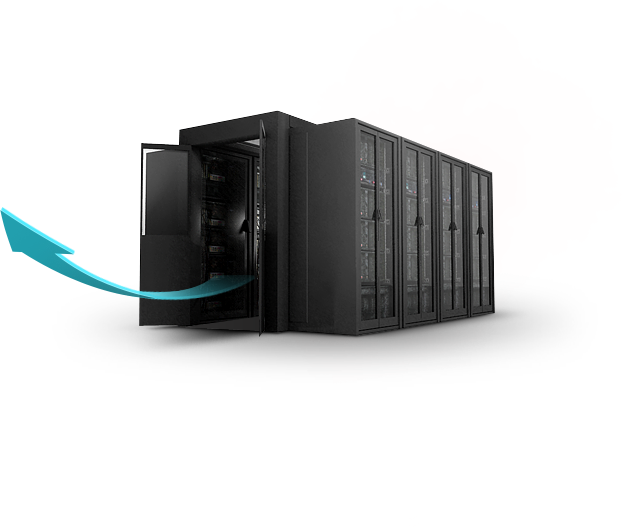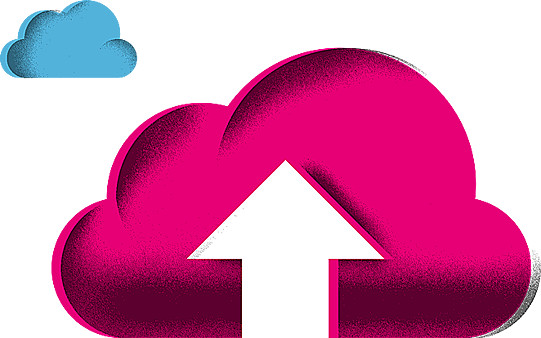The green
data bunker
Lack of space – The cloud is moving! The new accommodations
will not only be larger but will be greener as well.
And will also be recyclable if desired.
T he cloud has moved to a larger home in the summer of 2018. Deutsche Telekom has built a new data farm near Magdeburg, set among green meadows and Germany's best arable land. Those who want to know where their vacation photos are stored should come take a look here. Although such a visit would not be all that easy to make. A four-meter high earth wall against heavy vehicles, a barbed-wire fence, several hundred security cameras, access control systems, hand scanners and more would all prevent you from entering – at least if you come unannounced. When it comes to data protection, Deutsche Telekom doesn't kid around. The company's cloud data center in Biere near Magdeburg is considered to be one of the securest in the world. Designed as a TwinCore data center, is has an extra dose of security. Even in the very unlikely event that there is a fire inside the data center, the automated nitrogen steam doesn't immediately extinguish the flames and the servers all burn down to a crisp, the data would still be secure. That's because there is a complete copy of all the data from Biere at a twin data center located a mere 18 kilometers away in Magdeburg.
The cloud data center Biere is one of the most secure data centers on the planet
Deutsche Telekom's Cyber Defense Center defends the Fort Knox of data from hacker attacks. Security is priority number one for good reason: never before have there been so many cyber attacks as there are now. Experts are talking about a downright cyber war. That's why more and more people want to keep their data as secure as possible in the cloud, preferably in Germany. And that's also why, in turn, Deutsche Telekom expanded its cloud capacities in Biere and building a second brand-new, high-performance data center: Biere 2. 50,000 tons of concrete and 30,000 servers.
An enormous construction site
34,000 tons of concrete
An enormous construction site
30,000 servers
An enormous construction site
Top 10 of the greenest data centers
The cloud likes cool and green conditions
The cloud is certainly secure. But is it also green? The Internet devours vast quantities of energy. Greenpeace says that if the Internet were a country, it would have the sixth-largest energy consumption in the world. But it's not only the servers in the data centers that consume enormous amounts of energy. The server cooling system is a real energy guzzler as well. Excuse me: was a real energy guzzler. Deutsche Telekom came up with a few clever ideas for quenching its cloud's energy thirst and lowering it by almost one-third. The video on Data Center 2020, Deutsche Telekom's research data center, explains these clever ideas.
See how the DataCenter2020 works
The internet is an enormous energy consumer. Telekom came up with a few very smart tricks to make the internet greener.
Besides, the cloud is actually even green before its birth. To elucidate, let's take a look at the construction of Biere 2, where a web-based logistics tool was optimizing all of the transportation routes on the site. Deliveries were managed "just-in-time"; in other words, concrete, wood, steel and cables were delivered exactly when they were needed. This way there were no trucks stuck in traffic at the site, with no engines or ACs running unnecessarily and polluting the environment. Construction timber was purchased from a dealer right around the corner, saving fuel and reducing CO₂ emissions.
An enormous construction site
34,000 tons of concrete and 30,000 servers: The Twincore data center Biere 2 during construction. Already on the construction site, special care was take to protect the environment. Find out how that worked...
A special washing facility set up at the site for concrete mixers washed these vehicles before they leave the site, thus promoting reuse of every last piece of concrete. There was even a vibration track installed in front of the exit to the site so that the dust on the construction vehicles falls off them while they were still on the site instead of when driving through the beautiful countryside. As if that weren't enough, the info graphic reveals a few more tricks. For example, how to recycle a data center.
The cloud data center Biere is among the ten greenest data centers on the planet
5
questions for...
Johannes Krafczyk5 questions for Johannes Krafczyk, Manager T-Systems
-
Have you ever recycled a data center?
Even a mega data center like the one we have in Biere can be completely dismantled. The ability to do that combined with the large amount of recycling materials it produces, is at the heart of sustainable building practices. Being able to reuse technology after dismantling a data center, whether servers or generators, plays a key role. If the technology cannot be reused, it is disposed by the manufacturer or specialized companies in compliance with environmental standards. We've undertaken this process with several older data centers over the past few years. We can even completely dismantle the building envelope. However, the buildings are typically later used for other purposes to the extent their condition allows.
-
Isn't a job at the data center a rather warm proposition in the long run?
Actually, the very opposite is the case :-) Even though spending time around generators will make you sweat. The motors are kept warm at all times to keep them from being damaged during quick system starts. The IT rooms are also kept at a comfortable temperature, even when it's hot outside. Because data center operation is fully automatic, people usually don't work in these areas.
-
Why does Biere use a third less power than traditional data centers?
There is no way around the fact that data center energy consumption is very high. After all, the servers need to be cooled around the clock. But by using smart structure and organization in the IT rooms, we can keep the amount of energy needed for cooling relatively low. In the upcoming expansion of the data center we will also be focusing on creating an efficient interplay between the technical components. That simplifies maintenance and reduces energy consumption, which also saves us money. And we continue to learn from the process. We employed a special cooling technology during the first building phase. We cool the servers exclusively with fresh air or evaporative cooling 300 days out of the year. We only switch on the cooling machinery on the hottest days. That reduces our energy consumption by around 30 percent compared to data centers using conventional cooling technology.
-
Does waste separation really take place at the Biere construction site?
Absolutely. The waste produced at the data center is separated according to various criteria, not that different, actually, than what you might do in your own home. The raw materials are recycled whenever possible. This simplifies construction logistics, improves safety and lowers costs. And both the workers and the contractor find a clean construction site motivating :-)
-
Do you have another example of environmentally friendly practices at the site?
One interesting thing that happened when we were building Biere was having to relocate 30 field hamsters. They had made themselves comfortable at the construction site and needed a new home. So we made some calls to the local farmers. The challenge here was to make sure their new home was far enough away so that the hamsters wouldn't come back. The farmers also needed to guarantee that they would only plant certain types of grain and use natural fertilizers. And they had to make sure to keep a strip of around two meters from the hamsters' source of food when mowing the fields. With the help of building biologists, we were able to properly relocate the hamsters and then stopped construction for two weeks in case some of them came back. We now pay the farmers compensation for their efforts, guaranteeing that the hamsters won't lose their new home.
One thing is certain: With its LEED (Leadership in Energy and Environmental Design) certification, the Biere cloud data center is one of the 10 greenest data centers on the planet. Nevertheless, this is only one of many components of Deutsche Telekom's climate protection strategy. Our goal is not limited to merely decreasing our CO₂ emissions as a company. Rather, we want to enable everyone, including you, to save energy and CO₂ through an intelligent, green network. From the smart home to smart cities to the connected cow, the connected bee and the connected corn field, everyone is getting involved! Become a part of the trend and use digital tools to conserve the environment. Another devoted assistant will be at your side starting next summer: Biere 2.
Almost
30%
less energy usage in the
data center Biere*
Our goal is not limited to reducing our own CO₂ emissions as a company. Instead, we want to make it possible for every one to save on CO₂ and energy by providing an intelligent, green internet.







